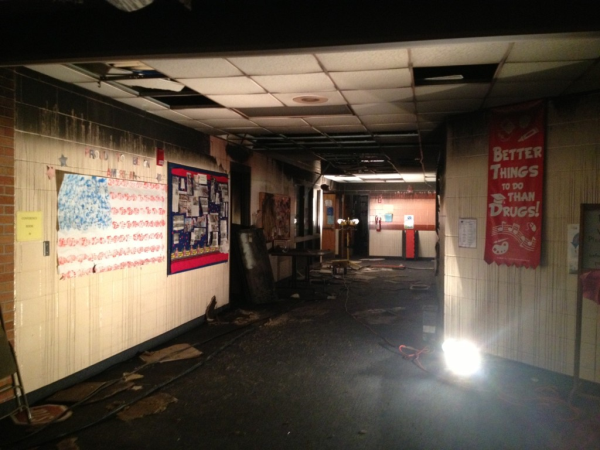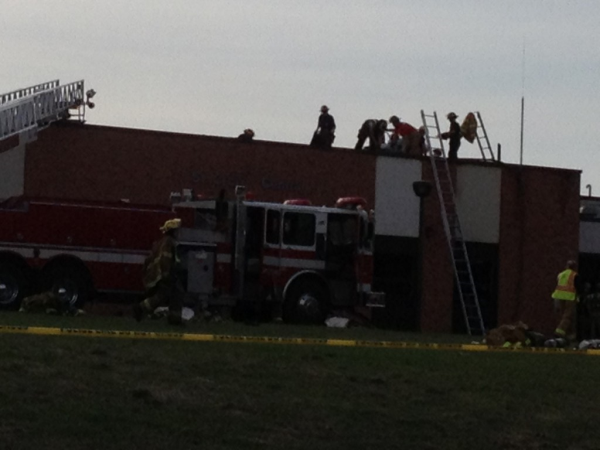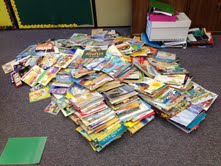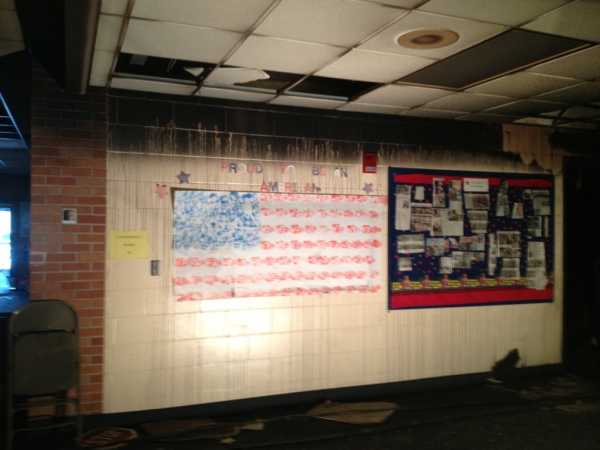VariQuest is excited to open our blog to educators across the country who are interested in sharing their ideas, stories and opinions with our network of teachers, administrators and more. If you have something you would like to share, please let us know! Email your ideas to variquest@variquest.com.
“The school is on fire…thought you’d want to know.”
This is the text message I woke up to on April 30th at 4:20am. My first thought? ”The memory books! Eight months of their best work!” I had no idea at this moment what our community would face in the days, weeks, and months to come.





As I sat at home watching the school burn on the news that morning, I went through my classroom in my mind. I went from the kids’ memory books, to the 15 tubs of handmade center activities in the cupboards, the hundreds of homemade posters, and the thousands of dollars worth of my own money that sat in that room. I decided I couldn’t sit at home and do nothing anymore, so I drove to the school and sat on the curb with my coworkers while the firefighters continued to break through the roof of our school to distinguish the flames.
The following days were filled with meetings, tears, letters to parents, tears, planning for the rest of the year, and more tears. While my original thoughts were on what I had lost inside those four walls, my team had to switch our thinking to the remaining 24 days of the school year. Fortunately, we had great leadership and an outstanding community who came together to make the last month of school the very best it could be. In just five days our community, led by an amazing principal, transformed an abandon girl scout camp into a school for over 600 students. Carpet was laid, desks were brought in, partitions were put up, portable toilets were set outside, truckloads of supplies were brought over, and our school’s flag was hung on our new school grounds. Panther Camp was in session. An awful situation was turned into a great community building project and became an experience none of us will ever forget.
I have never been so excited to see 22 smiling kindergarteners get off the bus on Monday morning. When I asked my kinders on the first day how they were feeling about being at Panther Camp, they replied with, “I was happy to see the my teacher was smiling when we got off the bus,” “I am glad my teacher is okay,” (many of the kids thought the teachers were hurt since in their eyes we live at school) and “I feel a little bit sweaty.” (All feelings that I was experiencing as well) I quickly realized that preparing for Panther Camp was not the hard part; it was trying to make their time there productive. 150 kindergarteners and seven kindergarten teachers were in an open space smaller than two classrooms. You cannot begin to imagine the chaos; when I think back on it, I feel as though I dreamt it. In keeping with routine, the other six kindergarten teachers and I tried our hardest to collaborate and plan 12 centers for all 150 kids. The only way to escape the noise was to bring my 22 kindergarteners into the supply closet off the main area. Panther Camp was fun and exciting for the first day, but after 24 mostly rainy days, my kinders were saying to me, “Do I have to go to the tiny room…again?” and “Why does the tiny room smell so bad?” There was more arguing, bullying, and physical altercations during that last month of school than I’ve ever seen before. While most people would consider the abundance of ticks and mice a nuisance, we used them as a learning tool. We learned the difference between male ticks and female ticks. It was fun to see the kids shout out, “It’s a boy!” Our “tick count” (a piece of masking tape that we hung on the door to collect the ticks each day) typically averaged about 30 ticks a day.
Panther Camp certainly tested my teaching ability. What can you do with 22 kids in a closet with nothing but a clipboard, a pencil, and a piece of paper? The opportunities are endless. We did a lot of hiking on the days that weather permitted (these were few and far between in May 2013). We learned to play outdoor games, my favorite being “Drip, Drip, Splash.” We tie dyed, wrote words with sticks, looked for animal tracks, went on bear hunts, and sang camp songs – all activities that you do not take time to do under normal circumstances.
I have a special connection with the Kindergarten class of 2013 – one that you can only get by spending 24 days stuck in a closet with them. I was so sad to send this group of kids to first grade, but I have to admit that I was definitely ready to say goodbye to Panther Camp.
Unfortunately, the end of Panther Camp was only the beginning of the reconstruction of our school. I spent three days in May taking inventory of the items in my room. I threw away 3,000 trade books that I had been collecting since my freshman year of college. I threw away all of the most important projects the kids had done over the first eight months of their school career. I threw away the rocking chair that my mother had used in her kindergarten classroom for her 35 years of teaching. The poor ServiceMaster cleaners had to listen to me cry for three days begging them to let me save the kids’ work and so many other items that I can only imagine seemed completely insignificant to them.
Walking through the halls with black soot covering the children’s projects on the walls was incredibly surreal. It was hard to believe I had walked through the same halls hundreds of times and thought of it as a safe and happy place.
After going through my classroom and all of its contents, I had to sign my name on a form giving them permission to send absolutely to the dumpster. It seemed completely hopeless that I would ever get back what I had worked so long to build.
I spent the summer flipping through catalogs putting together a forty page purchase order. My mother got right to work recreating the centers and activities that once filled the cupboards of my classroom. I recruited help from family, friends, community members, and friends of friends to donate time and supplies. Two days before the new Kindergarteners and their families came to Open House on August 28th, I was allowed into my “new” classroom. When I walked in, all I saw was an enormous pile of boxes stacked in the middle of the room. I worked more than 30 hours in two days to unpack the boxes and shove things in the cupboards. With the help of many volunteers, it miraculously looked like a kindergarten classroom when the kids got there. I put on a happy face and met my new students. But when I looked around the room, all I could see was what was missing. I had no furniture, nothing in my filing cabinets, bare walls, and nothing to do with kids. I felt like a new teacher, only worse because I knew what I was missing and I wanted it all back…NOW!
I have been with this class for a few weeks now and I am still missing so much. But I have learned that life goes on. If I can survive this, I can survive anything. I am so thankful for all the love and support so many people have shown…there is no way I could do this without them.
While my classroom is still nowhere near what I want it to be, I am taking it one day at a time. Teachers put their hearts and souls into their jobs; they know how unsettling it is to feel unprepared for their students. But I keep telling myself that it will get better and I will be ready again someday. This rebuilding is a long and far-reaching process. I’m sure by this time next year, I’ll feel at home in my new classroom.
 Heidi Sirek
Heidi Sirek
Heidi Sirek is a 4th-year kindergarten teacher at St. Croix Central Elementary in Roberts, WI. She graduated from the University of Wisconsin – River Falls and is currently working toward her Masters degree in Reading.






![[Lesson Plan Activity] ELL Bingo](https://content.cdntwrk.com/mediaproxy?url=https%3A%2F%2Finfo.variquest.com%2Fhubfs%2F3D%2FLesson_Plan_Pics%2Fell%2520bingo%2520header.png&size=1&version=1753195128&sig=ebc051ac021c1960f75e8f80a97d9355&default=hubs%2Ftilebg-blogs.jpg)
![[Lesson Plan] First Day of School Feelings](https://content.cdntwrk.com/mediaproxy?url=https%3A%2F%2Finfo.variquest.com%2Fhubfs%2Fimages%2FProducts%2FCutout_Maker%2Fthe%2520start%2520of%2520a%2520new%2520school%2520year%2520cutout%2520maker.jpg&size=1&version=1752780346&sig=847b11606c169458fea71bb69e2360e0&default=hubs%2Ftilebg-blogs.jpg)
![[Lesson Plan Activity] Kindness Calendar](https://content.cdntwrk.com/mediaproxy?url=https%3A%2F%2Finfo.variquest.com%2Fhubfs%2F3D%2FLesson_Plan_Pics%2Fkindness%2520calendar%2520header.png&size=1&version=1752703157&sig=3fa07390d2b175137c148d7763d6a980&default=hubs%2Ftilebg-blogs.jpg)





![[Lesson Plan] Celebrate the Chinese New Year 2025!](https://content.cdntwrk.com/mediaproxy?url=https%3A%2F%2Finfo.variquest.com%2Fhubfs%2FCarman%2FCNY%25201-2018%2F%25E6%2581%25AD%25E5%2596%259C%25E7%2599%25BC%25E8%25B2%25A1.png&size=1&version=1737070708&sig=d89d716a42e2737ee7122119d2052225&default=hubs%2Ftilebg-blogs.jpg)


![[Lesson Plan] Election Activities for Grades 2-6](https://content.cdntwrk.com/mediaproxy?url=https%3A%2F%2Finfo.variquest.com%2Fhubfs%2FLesson_Plan_PDFs%2Felections%2520lesson%2520plan%2520header%2520blog.png&size=1&version=1730049507&sig=c8f9bdb2545ac4d7408ee3c224f15b3d&default=hubs%2Ftilebg-blogs.jpg)





![[Lesson Plan] Arbor Day Activities for Grades 4-6](https://content.cdntwrk.com/mediaproxy?url=https%3A%2F%2Finfo.variquest.com%2Fhubfs%2FLesson_Plan_PDFs%2Farbor%2520day%2520activities%2520blog%2520header.png%23keepProtocol&size=1&version=1713281322&sig=fa93c6558caab80b84ee1b7a3f74e75c&default=hubs%2Ftilebg-blogs.jpg)
![[Lesson Plan] SEL Photo Activities for Grades 5-7](https://content.cdntwrk.com/mediaproxy?url=https%3A%2F%2Finfo.variquest.com%2Fhubfs%2FLesson_Plan_PDFs%2FSEL%2520Photo%2520Activities%2520header.png%23keepProtocol&size=1&version=1712432018&sig=36043467659cdc58fd01a7c4e0b4e10f&default=hubs%2Ftilebg-blogs.jpg)